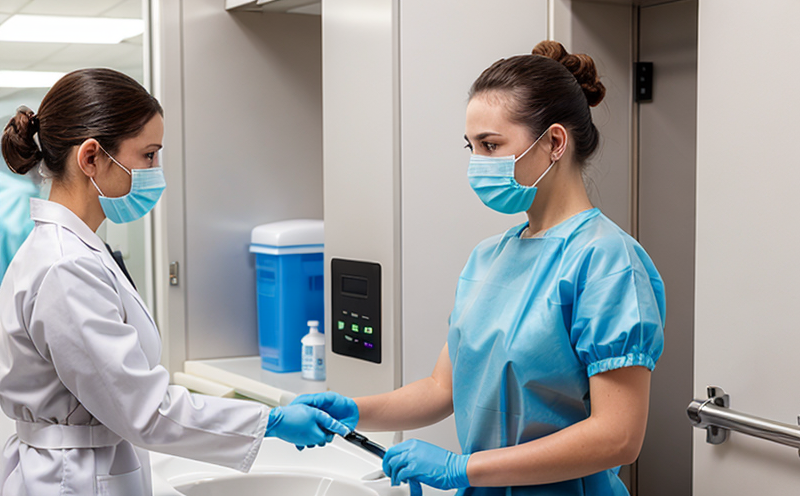JIS L1922 Testing for antiviral activity of textile products
The JIS L1922 standard is a recognized method used to evaluate the antiviral efficacy of textiles. This testing protocol is particularly important in sectors like healthcare, where fabric integrity and hygiene are paramount. The primary purpose of this test is to determine whether fabrics possess sufficient antiviral activity to inhibit or reduce viral replication on their surfaces.
The process involves exposing textile specimens to a standardized virus suspension under controlled conditions. After exposure, the survival rate of the virus on the fabric surface is assessed both before and after treatment with an antimicrobial agent. If there is significant reduction in the virus population post-treatment compared to pre-treatment levels, it indicates effective antiviral activity.
This testing method is critical for ensuring that textiles meet stringent hygiene requirements set by international standards such as JIS L1922. Compliance with these standards can significantly enhance brand reputation and customer trust, especially in markets where hygiene and safety are key considerations.
The test procedure requires meticulous specimen preparation, including the correct handling of fabrics to avoid contamination or damage that could skew results. Specimens must be cut into standardized pieces, which are then exposed to virus solutions according to specified conditions.
Post-exposure, the samples undergo rigorous analysis using techniques like plaque assays to quantify viral loads accurately. The data collected helps in determining whether the textile possesses adequate antiviral activity and meets the required standards.
The JIS L1922 protocol is widely used across various industries, including healthcare apparel manufacturing, where it ensures that products are safe for use by patients and staff alike. In summary, this testing method provides a robust framework to assess the antimicrobial properties of textiles, ensuring they meet critical hygiene benchmarks.
Scope and Methodology
| Step | Action |
|---|---|
| 1 | Select appropriate virus strains for testing based on the intended application of the textile. |
| 2 | Prepare standardized virus suspensions according to JIS L1922 guidelines. |
| 3 | Expose fabric specimens to the virus suspension under controlled conditions. |
| 4 | Incubate samples for a specified period, allowing sufficient time for viral replication. |
| 5 | Remove the virus from the treated and untreated fabrics using standardized procedures. |
| 6 | Analyze the viral load on both pre- and post-treatment specimens using plaque assays. |
| 7 | Calculate the reduction ratio to determine antiviral efficacy. |
The methodology outlined in JIS L1922 ensures that all tests are conducted under consistent conditions, leading to reliable and reproducible results. This approach is essential for maintaining high standards of hygiene across different sectors where textiles play a crucial role.
Eurolab Advantages
At Eurolab, our commitment to excellence extends beyond just providing accurate test results; we offer comprehensive services that cater specifically to the needs of your business. Our team of experienced professionals ensures that every aspect of JIS L1922 testing is meticulously handled from start to finish.
- Expertise: Leveraging our extensive knowledge and experience, Eurolab can guide you through the entire process, from specimen preparation to final analysis.
- Precision: Our state-of-the-art facilities equipped with cutting-edge technology guarantee precise measurements and accurate results.
- Rigorous Quality Control: We adhere strictly to international standards ensuring that all tests meet the highest quality benchmarks.
- Comprehensive Reporting: Eurolab provides detailed reports tailored specifically for your requirements, offering insights into not only compliance but also areas where improvement could be made.
We understand how important it is to have reliable data when making decisions about product development or ensuring regulatory compliance. By partnering with us, you can rest assured that every step of the JIS L1922 testing process will be conducted efficiently and effectively.
Environmental and Sustainability Contributions
- Eco-Friendly Products: Ensuring our clients' products are safe and effective contributes positively to environmental sustainability by reducing the risk of harmful bacteria or viruses spreading through fabrics.
- Sustainable Manufacturing: By promoting the use of textiles with proven antiviral properties, we encourage sustainable manufacturing practices that prioritize public health without compromising on ecological balance.
- Reduced Waste: Effective antimicrobial treatments help extend fabric lifespan, thereby reducing waste and resource consumption associated with frequent replacements.
The JIS L1922 testing ensures that the textiles we produce are not only beneficial but also environmentally responsible. This dual benefit aligns perfectly with global efforts towards sustainable development goals.





